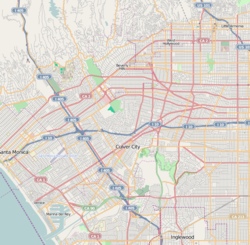| Saban Building | |
|---|---|
 The Academy Museum of Motion Pictures' Saban Building in 2021 | |
 | |
| Former names |
|
| General information | |
| Status | Completed |
| Architectural style | Streamline Moderne |
| Location | 6067 Wilshire Blvd., Los Angeles, CA 90036, U.S. |
| Coordinates | 34°03′48″N118°21′40″W / 34.0633°N 118.3610°W |
| Named for | Cheryl and Haim Saban |
| Construction started | 1938 |
| Opened | 1939 |
| Renovated | 2021 |
| Renovation cost | $368 million |
| Owner | Academy Museum of Motion Pictures |
| Technical details | |
| Material | Concrete and steel |
| Floor count | 6 |
| Design and construction | |
| Architect(s) | Albert C. Martin, Sr. |
| Renovating team | |
| Architect(s) | Renzo Piano |
| Other information | |
| Public transit access | |
| Website | |
| academymuseum | |
| Built | 1939 |
| Built for | May Company |
| Original use | Department store |
| Rebuilt | 2020 (expected) |
| Architect | Albert C. Martin, Sr. |
| Architectural style(s) | Streamline Moderne |
| Designated | September 30, 1992 [1] |
| Reference no. | 566 [1] |
The Saban Building, formerly the May Company Building, on Wilshire Boulevard in the Miracle Mile district of Los Angeles, is a celebrated example of Streamline Moderne architecture. The building's architect Albert C. Martin, Sr., also designed the Million Dollar Theater and Los Angeles City Hall. The May Company Building is a Los Angeles Historic-Cultural Monument. [2] The building was operated as a May Company department store from 1939 until the store's closure in 1992, when May merged with J. W. Robinson's to form Robinsons-May. The building has been the home of the Academy Museum of Motion Pictures since 2021.
Contents
- History
- May Company
- LACMA West
- Academy Museum of Motion Pictures
- Appearances in popular culture
- References
- External links
The Los Angeles Conservancy calls it "the grandest example of Streamline Moderne remaining in Los Angeles". It is especially noted for its gold-tiled cylindrical section that faces the intersection of Wilshire Boulevard at Fairfax Avenue, of which it occupies the northeast corner. [3]


